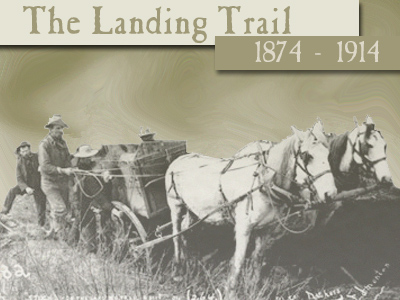|
|
Raynor Whitely Describes His Family's Stopping Place |

Mr. Bunn has returned . . . from the Athabasca . . . and considers that the road can be practical and that 12 men in the course of a summer with a good superintendent could make a passable road. —Hardisty to Donald Smith at Ft. Garry, 1874.
The road to Fort Assiniboine is a very bad one, so bad that freighters won't attempt it; several animals have been entirely ruined in going through the road in summer time . . . From Indians acquainted with the country, I have been informed that a good road could be made with very little trouble to a point on the Athabasca, two days down from Fort Assiniboine, which would shorten the trip [to Lesser Slave Lake] by land as well as by water by two days. —Hardisty to Chief Commissioner James Grahame on June 8, 1875. (Quoted in Athabasca Historical Society 1986, 18)
In September 1875, Chief Factor Hardisty would finally convince Robert Hamilton, the Hudson’s Bay Company’s Inspecting Chief Factor, that the Athabasca River provided a viable way around the bottleneck of the Fort Assiniboine Trail. Hamilton authorized immediate construction of a trail from Fort Edmonton to Athabasca Landing, and stayed to supervise the work.
The construction proceeded slower than expected, as Hamilton reported to Commissioner Grahame on Christmas Eve:
I had hoped that this road would have been completed this Autumn but owing to the difficulty of procuring good laborers at that season it was only opened out about halfway. I am in hopes however that it will be completed in ample time next spring to enable the returns from Lesser Slave Lake to be brought out that route. It is computed that the new road will not be over seventy miles in length while the route by way of Ft. Assiniboine is fully ninety and as I said before through very bad country. (Quoted in Athabasca Historical Society 1986, 18-19)
The trail was completed at the cost of $4059.00, and “from 1877 onwards was the Company’s main route to the Peace Country." In fact, the trail turned out to be 100 miles long and travellers faced two prime nemeses: bugs and mud.
The flies bothered us greatly; the large bulldogs, looking like a cross between a bee and a blue-bottle, drove the horses almost to madness, and after our midday halt it was no easy matter to put the harness on; fortunately we had netting, or the poor beasts would have fared much worse: as it was the blood was streaming from their flanks during the heat of the day. The mosquitoes appeared towards evening, but as the nights were usually chilly they annoyed us only for a few hours. (Quoted in Athabasca Historical Society 1986, 34)
When there was any rain at all, the trail became so muddy that it was nearly impassable. Also, when it was used heavily, it deteriorated quickly.
They left [Edmonton] July 4 for Colinton with some other settlers, six wagons in all. It took them thirteen days. The Athabasca Landing Trail was just a series of mudholes. They got stuck, put all six teams on each wagon and pulled each one through the mudhole by that time they were in another mudhole. (Quoted in Athabasca Historical Society 1986, 98)
A number of stopping places along the way — Newton Egge’s Half-way house and Billy Smith’s at Meanook and Whitely’s in Perryvale — provided travellers with a place to stay overnight. Some provided food and accommodation for travellers and a livery stable, while others did not. A stagecoach service between Edmonton and Athabasca Landing was started by J.H. Kennedy in 1898, but primarily the trail was used by freighters and later by settlers.
Home | Hudson's Bay Company Post | The Landing Trail | Society, Gender, and Race | Transportation Hub | Boatbuilding | To the Klondike | The Commercial Boom | Amber Valley | The Athabasca Bore | Agriculture and Settlement | Then and Now